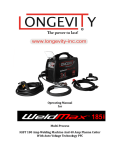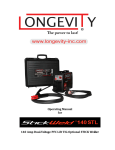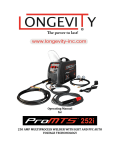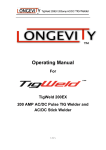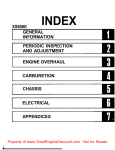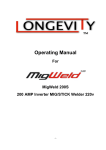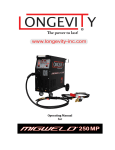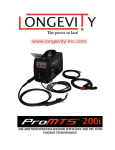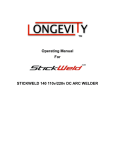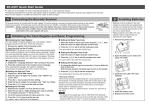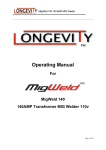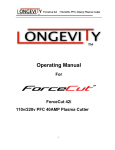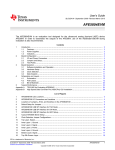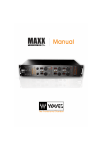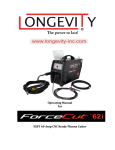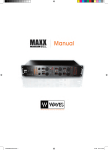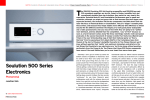Download Longevity 444528 Instructions / Assembly
Transcript
Operating Manual for 250 Amp AC/DC Pulse IGBT TIG Welder With PFC Technology TIGWELD® 250 EX Table of Contents Table of Content Pg. 1 Thank you From LONGEVITY Pg. 2 Warranty/Shipping Damage/Order Information Pg. 3 Safety Information Pg. 4-5 Specifications and Ratings Pg. 7-8 Main Unit Knob/Button/Function Diagram Pg. 9-10 TIG Pulsing Pg.11 TIG Section: Torch Assembly Pg. 12 Selecting the Right Tungsten Pg. 13-14 Selecting the Right Filler Rods Pg. 15 Argon Regulator Installation Pg. 16 Basic TIG Operation Pg. 17-20 Basic Stick/Arc Welding Operation Pg. 21-25 Routine Maintenance Pg. 26 Troubleshooting Pg. 27 THANK YOU! www.longevity-inc.com 1 TIGWELD® 250 EX We, at LONGEVITY, want to thank you for purchasing our product. You are almost ready to experience Longevity Welding first hand. Longevity definitely appreciates your business and understand that this equipment may be overwhelming to setup and operate so we have prepared a manual that will assist you in understand your new plasma cutter/welder. If you have any questions during or after reading this manual, please feel to contact us! Please take a moment to register your product on our website at www.longevity-inc.com or www.lweld.com Once again, thank you for choosing Longevity as your main welding supplier! Longevity Global, Inc 23591 Foley St Hayward, CA 94545 Toll-Free Customer Support: 1-877-LONG-INC / 1-877-566-4462 Website: www.longevity-inc.com Sales: [email protected] Customer Service: [email protected] Dealers: [email protected] Complaints: [email protected] Please join our welding forums to share welding tips and tricks, to receive useful information from customers who also use our products, and to be a part of the Longevity™ welding community at www.freeweldingforum.com www.longevity-inc.com TIGWELD® 250 EX Warranty LONGEVITY Plasma Cutters, Welders, and Multi-Purpose Welders are covered for specific Parts and Labor warranty at our facility. For detailed information regarding your specific LONGEVITY welder or cutter, please view our Terms and Policies page on our website at the following website link: http://www.longevity-inc.com/terms/ Shipping Damage Your machine is insured against damage during shipping. Keep all packing materials and containers in case machine must be returned. We will initiate a claim with the shipping company to cover damage or loss. If there is shipping damage upon opening your package, our customer service team will work with you to get the matter resolved. In Warranty Service Customers, who own machines that are in warranty and require service, should contact our Warranty Department by email at [email protected] to obtain a return authorization code. In addition to the warranty we offer, we would like for you to register your product on our website at www.longevity-inc.com/resources. Remember, warranty starts from the date of purchase. For your convenience, write your order information below so you can track your order in case you need warranty work. Order No.: _________________________________ Date of Purchase: _____________________________ Warranty Period: ______________________________ Out-of-Warranty Service Customers, who own machines that are out of warranty and require service, should contact us for an estimate. Longevity offers an exchange program on out of warranty units. We also help non LONGEVITY customers with repairs, replacement, and service. If your unit is not manufactured by Longevity and you cannot receive service from your manufacturer or seller, Longevity will lend out hand. Our warranty policy is also available for all plasma cutters and welders. For more information, please email us at [email protected] www.longevity-inc.com 3 TIGWELD® 250 EX Warnings and Safety Welding and plasma cutting may be dangerous to the operator and to bystanders, if the equipment is not operated properly. Welding or cutting must be performed in accordance with all relevant safety regulations. Carefully read and understand this instruction manual before installing and operating this equipment. Changing function modes during welding may damage equipment. Before welding, disconnect the electrode-holder cable from the equipment. A circuit breaker is required to prevent electrical overload of the equipment. Only high quality welding tools should be used. Electric Shock can be fatal. Ensure that ground cable is connected in accordance with applicable safety codes. Never touch electrodes, wires, or circuit components with bare hands. Wear dry welding gloves when welding. The operator must be insulated from the work piece. Smoke and gas can be harmful to health. Ensure that the working area is well ventilated. Avoid breathing smoke and gas generated during the welding process. Cutting and welding can cause cancer because of the smoke that comes from the welds and cuts. Arc-light emission can be harmful to eyes and skin. Always wear a welding helmet, anti-radiation glass, and work clothes while welding. Ensure that people in or near the working area are protected. Welding splash is a fire hazard. Keep flammable material away from the work place. Keep a fire extinguisher nearby, and have all personnel trained in it’s use. Surface noise generated while welding or cutting can be harmful to hearing. In the event of a machine fault. Refer to this instruction manual. If the fault cannot be determined, contact your local dealer or supplier for assistance. www.longevity-inc.com TIGWELD® 250 EX Safety Tips Consider the following tips to ensure safe operation of your welding/cutting equipment: Ensure that this welding equipment is installed in an area free of corrosive chemical gases, flammable gases or materials, and explosive chemicals. The area should contain little dust, and have a humidity of no more than 80%. Operate the welding equipment in an area sheltered from direct sunlight and precipitation. Work area temperature should be maintained at -10C to +40C; If, because of an overload, the machine suddenly stops, and it is necessary to restart it, leave the internal fan operating to lower the inside temperature. Always wear protective clothing and a welding mask to protect your skin. Wear safety goggles designed to darken the arc generated by your machine. Wear suitable noise protection to protect your hearing. Ensure that machine is grounded through the power cord or on the machine case. Never operate the machine in bare feet or on a wet floor. Never switch the machine off while it’s in use. Doing so will damage the internal circuitry. Ensure that your circuit breaker is rated to handle the current requirements of your machine. Use a UL approved receptacles and plugs with your machine. Never hard wire the machine to main power. Work in a well ventilated area to avoid smoke. Keep your head out of the smoke. Ensure that air is flowing away from you to avoid inhaling smoke. Ensure proper ventilation through the machine’s louvers. Maintain a distance of at least 12 inches between this cutting equipment and any other objects in the work area. Use a screen or curtain designed to keep passers by from viewing the arc. The arc spray and metal spray from machine use may cause nearby fires. Use caution. If, after reviewing this manual, you have any problems in setting up or operating your machine, contact us at [email protected]. www.longevity-inc.com 5 TIGWELD® 250 EX Main Unit Amp Adjust TIG Torch and TIG Torch Pieces Stick Electrode Holder Foot Pedal Ground Clamp Air Hose and Ground Clamp *Not pictured Argon Regulator *Different then pictured. www.longevity-inc.com TIGWELD® 250 EX Techinical Specifications and Ratings MODE TYPE PARAMETER TIGWELD® 250 EX TIGWELD® 250 EX Power Voltage 1Phase, 110/220v ±15% Input Frequency 50/60 Hz Inverter IGBT Protection Class IP23 Weight 49 lb Size (unit only) L: 19.6 in x H: 15.25 in x W: 9.25 in (AC) 10-250 A AC TIG Output (DC) 5-250 A DC TIG Arc Starting Mode HF / Lift-TIG 220v 35% @ 250 A 60% @ 210 A 100% @ 190 A Rated Duty Cycle at Max Amps 110v 35% @ 120 A 60% @ 110 A 100% @ 100 A Max Amps 10-250 A 220v STICK 35% @ 160 A 60% @ 130 A 100% @ 100 A Rated Duty Cycle at Max Amps 110v 35% @ 100 A 60% @ 90 A 100% @ 80 A www.longevity-inc.com 7 TIGWELD® 250 EX Weld Method Parameter STICK HF TIG LIFT TIG Pre Flow 0.1-9.9s NO YES YES P.P. Current 5- NO YES YES Post Gas 0-25s NO YES YES Up-Slope Time 0-10s NO YES YES Down-Slope Time 0-10s NO YES YES Pulse Frequency (DC TIG) 0.5-500Hz NO YES YES Pulse Wide Range (AC TIG) 0.5-10Hz NO YES YES Cleaning Effect +30% -30% NO YES YES I/Hot 0-2s NO YES YES Arc Force 0-100% NO NO NO 0-100% NO NO NO T/Hot www.longevity-inc.com TIGWELD® 250 EX DECRIPTION OF CONTROL PANELS No. FUNCTION 1 Pre-Flow Indicator 2 Starting Amp Indicator For TIG Welding 3 Upslope Time Indicator Period in TIG welding during which the starting current is increased to the specified main current 4 Welding Amps Indicator Main Amps 5 Peak Amp Indicator Pulse Peak Amps (1-100%) 6 Downslope Time Indicator Period in TIG welding during which the specified main current I1 is lowered to the final currentI 7 Ending Amps Indicator For TIG Welding 8 Argon Stopping Indicator For TIG Welding 9 Foot Switch Indicator Lights up if foot switch is connected 10 Hot Start For Stick Welding 11 Arc Force For Stick Welding 12 TIG AC Welding Indicator ON/OFF 13 TIG DC- Indicator 14 TIG DC+ Welding Indicator www.longevity-inc.com DESCRIPTION 9 TIGWELD® 250 EX 15 Rectangle Wave Indicator 16 Sine Wave Indicator 17 Square Wave Indicator 18 Triangle Wave Indicator 19 Pulse ON Indicator 20 Pulse OFF Indicator 21 Gas Test Indicator 22 TIG Mode 23 Stick Mode 24 2-Step Mode Indicator 25 4-Step Mode Indicator 26 Pulse Mode Indicator 27 HF Contact Indicator 28 Lift-TIG Indicator 29 Power Indicator ON/OFF 30 Thermal Overload Indicator Lights up If the power source overheats (e.g. because the duty cycle has been exceeded). For more information on this, see the "Trouble shooting" section. ON/OFF When the Machine shuts down the yellow light will blink and the data will be saved. 31 Hot Start 32 Hot Time 33 AC Frequency 34 Parameter Adjustment Knob Used to adjust welding parameter. 35 Balance (-30%/+30%)Used to set the cleaning action for TIG AC welding. 36 Parameter Select Left 37 Parameter Select Right 38 Amps 39 Output Amps 40 Memory Display Memory display 1-9. 41 Store Button Used to store of to 9 different settings. 42 Polarity Select 43 Wave Form Selector 44 Pulse Selector 45 Gas Test Button 46 Process Button 47 Mode Button ON/OFF 48 HF Contact Button Select Lift-TIG or HF Start. Used to select wave form (Triangle, Sine, OFF or Rectangle) Used to set the required amount of shielding gas at the pressure regulator. After you press this button, gas will flow out for 30s. Press the button again to stop the test gas flow before the 30seconds are up. www.longevity-inc.com TIGWELD® 250 EX TIG pulsing The welding current set at the start of the welding procedure is not necessarily ideal for all welding process: - if the current is too low, the base material will not melt sufficiently, - if overheating occurs, the liquid weld pool may drip. The TIG pulsing function offers a solution (TIG welding with pulsing welding current): a low base current I-G rises steeply to the significantly higher pulsing current I1 and, depending on the set dcY (duty cycle) time, drops back to the base current I-G. In TIG pulsing, small sections of the welding location melt quickly and then solidify again quickly. In manual applications using TIG pulsing, the filler wire is applied in the maximum current phase (only possible in the low frequency range: 0.25 - 5 Hz). Higher pulsing frequencies are mainly used in automatic mode to stabilize the arc. TIG pulsing is used for out-of-position welding of steel pipes or when welding thin sheet. Mode of operation of TIG pulsing when TIG DC welding is selected: Legend: - IS Starting current - IE Final current - tUp Upslope - tDown Downslope - F-P Pulsing frequency (1/F-P = time interval between 2 pulses) - dcY Duty cycle - I-G Base current - I1 Main current www.longevity-inc.com 11 TIGWELD® 250 EX TIG Section: Setting Up The TIG Torch www.longevity-inc.com TIGWELD® 250 EX Selecting the Right Tungsten Electrodes: Selecting the right tungsten is crucial to a successful TIG weld. You have to insure the correct tungsten is used for the type of metal you are welding, the type of technology used in your welder such as transformer or inverter, and the thickness of the metal you will need to weld. This leaves you with a variety sizes ranging from 1/16 to 1/8” and the types of tungstens such as the Pure Tungsten (TP), 2% Thoriated Tungsten (TT2), 2% Ceriated Tungsten (TC2), and 2% Lanthanated Tungsten (TL2). Fortunately, LONGEVITY offers high quality tungsten electrodes and explains which tungsten is required for the right application. Pure Tungsten (TP) – (green tipped) - Pure tungsten readily forms a ball on the end. It is designed for use with transformerbased power sources for AC welding of aluminum. Unfortunately, LONGEVITY does not carry transformer based technology considering the size and weight of TRANSFORMER welders. Therefore, this tungsten is rarely sold buy our sales staff 2% Thoriated Tungsten (TT2) – (red tipped) - This tungsten is the most common tungsten currently being used with LONGEVITY DC TIG. It is generally utilized for DC welding of mild steel, bronze, and stainless steel and basically all metals except aluminum and offers excellent performance. A drawback is that this tungsten has a low level radiation hazard and the fact that they no recommend to weld aluminum. We recommend this tungsten with our stand alone DC only TIG Welders, our TIGWELD 250 EX multi-process welders, which feature DC TIG welders. The 2% Thoriated Tungsten works well with Inverter Welders. This is the tungsten to use for your welder. LONGEVITY does have them available. 2% Ceriated Tungsten (TC2) – (grey tipped) – 2% ceriated is an excellent substitute for 2% thoriated tungsten and is designed for transformer and inverter based power sources. For Transformer DC welding, this tungsten requires less amperage to start so it is recommended for thinner metals. It offers a stable arc and can be used for both AC and DC welding with inverter power sources and is our most popular sold tungsten because it can be used to weld every type of metal in both AC / DC modes in our LONGEVITY INVETER TIG welders. We recommend this unit with our TIGWELD 250 EX 250AMP ACDC TIG/STICK unit or our INNOVATOR series multi functional welders and plasma cutters because of the versatility of AC DC welding. 2% Lanthanated Tungsten (TL2) – blue tip – 2% lanthanated is probably the most popular substitute for 2% thoriated tungsten. Offering a longer life span than the 2% thoriated tungstens, it is a nice a nice alternative, but not as recommended as our 2% Thoriated Tungsten. This tungsten can be used with both transformer and inverter technology on both AC DC modes. www.longevity-inc.com 13 TIGWELD® 250 EX Tungsten Chart Guide Tungsten Type Diameter 040"(1.0mm) 1/16"(1.6mm) 3/32"(2.4mm) 1/8"(3.2mm) Pure Tungsten TP-7040 TP-7116 TP-7332 TP-718 2% Thoriated TT2-7040 TT2-7116 TT2-7332 TT2-718 2% Ceriated TC2-7040 TC2-7116 TC2-7332 TC2-718 2% Lanthanated TL2-7040 TL2-7116 TL2-7332 TL2-718 Amparage-Ac 20-30 30-80 60-130 120-200 Amparge-Dc 15-50 50-120 80-150 130-250 Sharpening a Tungsten Sharpening a tungsten is very important for a nice fine arc strike. There are auto sharpeners to place the perfect sharpening point on your tungstens or you can simply use a grinding wheel to sharpen your tungsten. Remember, after sharpening to a pencil point, you want to flatten the bottom for a good arc. www.longevity-inc.com TIGWELD® 250 EX Selecting the right FILLER RODS FOR TIG WELDING: Filler Rods are essential to TIG Welding because the filler rod is fed into the molten puddle by hand filling in the puddle to create a stronger metal bond or puddle to join two metal pieces. It is extremely important to have the right filler rod based on the metal you are welding. It is also necessary to have the right tungsten to insure you are properly setup to weld your metal. Part # Application: 4043-1/16-1 4043 Alloy Aluminum Wire 1/16" X 36" 4043-3/32-1 4043 Alloy Aluminum Wire 3/32" X 36" 5356-1/16-1 5356 Alloy Aluminum Wire 1/16" X 36" 5356-3/32-1 5356 Alloy Aluminum Wire 3/32" X 36" 308L-035-1 308L Stainless Steel Wire .035” x 36” 308L-1/16-1 308L Stainless Steel Wire 1/16" X 36" 70S6-1/16-1 ER70S-6 Steel Wire 1/16" X 36" 70S6-3/32-1 ER70S-6 Steel Wire 3/32" X 36" 70S2-1/16-1 ER70S-2 Steel Wire 1/16" X 36" 80SD2-1/16ER80SD-2 Steel Wire 1 E1/16" X 36" Longevity offers quality filler rods at affordable prices. Please take a look at the selection of filler rods that we carry to decide what the best application of rod will be for your weld. Your choice of filler rod is extremely important to the strength and matter density of your weld. You can determine the diameter of the filler rod needed, by the thickness of the material that you will be welding. Here are some pointers in deciding how to choose the correct filler rod for your weld. 1. 4043 is a general filler rod for most aluminum welding. Remember, the TIGWELD 250 EX is strictly DC welding so aluminum is not possible with the use of Argon. 2. 5356 is perfect for 5xxx series aluminum. If you are planning on anodizing the finished piece, this rod should be used for the weld. 3. ER70S-6 is designed for welding mild steel. 4. ER70S-2 is recommended for welding 4130 chrome moly tubing in most applications. www.longevity-inc.com 15 TIGWELD® 250 EX 5. ER80S-D2 is for welding 4130 chrome moly tubing if a higher strength weld is required. 6. 1/16” diameter filler should be used when material is 1/8” and less thick. 3/32” diameter filler rod can be used for 1/8” and thicker material. For more info on Filler Rods, go to www.freeweldingforum.com Setting Up the Argon Regulator: The argon regulator (pictured below) is included with your unit. Setting it up to your argon bottle is easy. Simply screw in the valve to the bottle and set the pressure to about. Use 100% Argon at 15-25 CFH (cubic feet per hour). Set the gas flow using the regulator on the gas bottle. Use higher flow when extending the tungsten electrode to reach into corners or gaps. We recommend about 18 CFH. Remember, that you also have a post flow setting on the unit to pass more argon after the arc to cool the electrode. Argon Regulator Assembled. *argon regulator may not be the same as pictured. www.longevity-inc.com TIGWELD® 250 EX Basic TIG Operation (Tungsten Inert Gas - Gas Tungsten Arc Welding - GTAW) TIG Operation and Principles: Shielding Gas: Use 100% Argon at 15-25 (cubic feet per hour). Set the gas flow using the regulator on the gas bottle. Use higher flow when extending the tungsten electrode to reach into corners or gaps. Tungsten Electrode: We recommend 2% Thoriated tungsten (red) for TIG welding with our DC TIG welders. Use smaller diameter electrodes for thinner metal (low amperage), thicker electrodes for thicker metals that require more amperage. For the right tungsten electrode, please refer to earlier in this manual or go to www.longevity-inc.com Filler Rod Selection: Depending upon the metal to be welded, filler rod selection is critical. Consult with your local welding supplier for the optimum filler rod to properly complete the weld. In certain applications, TIG welding can be performed without the use of a filler rod. Use free welding forum at www.freeweldingforum.com to gather advice or go to www.longevityinc.com. Pre-TIG Welding As you get to know the above information of basic TIG welding applications, there are a couple of basic steps that need to be taken. The tungsten must be sharpened and shaped before initiating an arc. With inverter TIG welding machines, tungsten sharpness is important. Your weld’s outcome will be partially determined by the shape of your tungsten. Sharpening an electrode consistently will cause an unstable, wandering arc, making it more difficult to control the weld puddle. Carefully rotate the tungsten as it is being ground to prevent a flat spot or a hollow ground point. Also note that tapering the tungsten to 2.5 times of its diameter is generally recommended for most DC welding applications. For high amperage DC welding, do not over sharpen the point, but leave a slight truncation on the end of the tungsten. This prevents the tungsten tip from breaking away and falling into the weld. It is also normal for a slight dome to form on the tungsten in DC mode. However, if the arc becomes erratic or the arc is difficult to start, regrinding the tungsten will be necessary. If the tungsten is accidentally dipped into the weld puddle, regrinding the tungsten will be necessary to eliminate contamination, particularly on aluminum. Grind tungsten’s only on a dedicated stone, free of contamination from other metals. www.longevity-inc.com 17 TIGWELD® 250 EX Starting a TIG Weld: Filler rod selection is critical to a TIG welds density, strength and purity. Check out our filler rod selection chart on our website for optimum filler rod to properly complete a weld. In certain applications, TIG welding can be performed without the use of a filler rod. One of the biggest issues for beginning welders is holding and maintaining an arc. Starting an arc with your High Frequency welder is quite simple. Set the machine for TIG operation then select the desired amperage. Grasp the torch in a manner that is comfortable to you. Place the torch so that the tungsten is no more than 1/8 inch from the weld surface. Depending upon the setup, either press the foot pedal down or press the trigger to initiate the high frequency arc. A small blue glowing cone may be observed. This is the high frequency arc. Immediately after that, you should see a strong and stable arc flowing from the torch. As the arc begins to grow, a molten puddle will appear. If it does not appear, stop your weld and increase the amperage. Repeat the start sequence. 1. To help the molten puddle form, slowly make small circles with the torch to build the heat in the weld area. A bright, fluid puddle will begin to form. 2. Once a uniform puddle is established, tilt the torch head about 75 degrees from the weld surface into the direction of the weld. This will direct the arc to the front of the weld puddle. 3. Grip the filler rod at a 15 degree angle to the weld surface with the other hand. Hold the rod in the iridescent cone of gas that surrounds the weld puddle. Do not hold it in the arc. Keep it close to the weld. A “skeleton” keyhole will begin to form in front of the weld. The keyhole is evidence that you are ready to add filler material and move forward. Introduce the filler rod into the key hole area underneath the arc. Wait for a single molten drop to fall off the tip of the rod. 4. When a molten drop falls from the rod, quickly remove the rod, keeping it inside the gas cone. The molten drop of filler metal should blend quickly into the puddle. 5. Move the torch forward slightly, carrying the keyhole with the weld. If the key hole is lost, then forward travel was too fast or too far. When the keyhole shows good development, repeat the steps 3-5 until you have a proper weld bead established. 6. Weld termination. When the weld bead has reached the desired length, add a final drop of filler and slowly circle the torch over the end of the weld to fill the crater. If the weld crater is not correctly filled, cracking and weld failure may occur. This is a small but important step to properly completing a weld. Release the foot pedal or release the trigger to stop. Keep the TIG torch in place until the post flow ends--usually around 5 seconds. 7. When finished welding always let the welder's fan run for a minute or two to cool the machine before turning the power switch off. Basic Diagrams of Welding Fig.1 Figure 1: Comparison chart of welds Fig. 2 www.longevity-inc.com TIGWELD® 250 EX Length of Arc When an arc is too long, the metal melts off the electrode in large globules and the arc may break frequently. This produces a wide, spattered, and irregular deposit with insufficient fusion between the base metal and the weld. When an arc is too short, it fails to generate enough heat to melt the base metal properly, causes the electrode Fig. 3 Setting the length of an arc to stick frequently to the base metal, and produces uneven deposits with irregular ripples. The recommended length of the arc is equal to the diameter of the bare end of the electrode, as shown in figure 3. The length of the arc depends upon the type of electrode and the type of welding being done; therefore, for smaller diameter electrodes, a shorter arc is necessary than for larger electrodes. Remember: the length of the arc should be about equal to the diameter of the bare electrode except when welding in the vertical or over- head position. In either position, a shorter arc is desirable because it gives better control of the molten puddle and prevents atmospherical impurities from entering the weld. www.longevity-inc.com 19 TIGWELD® 250 EX Sample of a quality stainless steel weld: TALLATION www.longevity-inc.com TIGWELD® 250 EX STICK/ARC Welding Stick Welding (Also known as MMA-Manual Metal Arc or Shielded Metal Arc WeldingSMAW) Connect the Stick torch to the - terminal and Torch Control receptacles. Connect the ground clamp to the + terminal and clamp the metal to be welded. Reverse the torch and ground connections for DCEP (Direct Current Electrode Positive). DC Stick - Select Stick, DC, desired amps using Base cur knob 1. Insert electrode into electrode holder. Position the electrode for the most comfortable position so that the electrode can be held directly over the work piece with a slight angle. 2. Set Amperage to the recommended amperage by the electrode manufacturer. Strike an arc by swiping it briskly across the work piece in the same manner as one would strike a match. Alternatively, you may strike an arc with firm tapping motion against the work piece. Either method is acceptable. An arc should initiate. Continue to keep the arc going by holding the electrode off the work piece no more than the electrode width. 3. Continue the arc by feeding the electrode into the weld puddle while moving the electrode forward. This will take some coordination, but will be fairly easy to do after practice. Do not allow the arc to become too long, because air and slag can become entrapped in the metal. The sound of a proper arc will be similar to a gentle frying sound. A long arc will emit a humming sound. An arc that is too short may be extinguished and the electrode may stick to the work piece. If the electrode sticks, immediately release the electrode from the electrode holder and break the electrode loose by hand. If the flux breaks off, simply trim off the excess rod until flux and bare metal meet. A welding rod must have flux to shield the weld from the atmosphere or the weld will fail. 4. Use the Basic Current control to change arc qualities. Adjust the amperage according to the recommendations of the electrode (welding rod) manufacturer for the type and size of the electrode used. When welding in the AC mode the AC Frequency control will affect how crisp the arc is, whether it is smooth and buttery or deeply penetrating. Use it to suit the desired weld finish. www.longevity-inc.com 21 TIGWELD® 250 EX Experimentation will be required to find the optimal setting desired. It is an excellent tool for out of position welding. 5. Electrode selection. Electrodes are usually given performance and characteristic ratings using a system of letters and numbers determined by the American Welding Society (AWS). The rating system includes the minimum tensile strength of the finished weld, the weld position (flat, vertical, horizontal, or overhead or a combination of two or more positions) and the flux type. Additional information may be given. Each manufacturer has their individual name and terminology as well. As there is no general recommendation that can be made about a particular electrode selection, except for practice welds, a electrode designated by the AWS as E 6011, E 6013, E 7014, or E 7018 may be used, each having its own distinct features and purpose. These are among the most common electrodes used in the industry and are not difficult to find. E 6011 electrodes are not as smooth running as some of the other electrodes, but offer the advantage of being able to weld on rusty metal and contaminated surfaces. It is widely used and requires very little skill to begin using. This is not a particular endorsement of an E6011, rather a simple example of what may be used in developing proficient technique. It is recommended that a variety of electrodes be used and practiced with. Consultation with an experienced local welding supplier will help greatly in determining what welding electrode is the best for your given situation. Many times, samples or small packages of electrodes are available at relatively low cost to determine for yourself the best electrode to use. Stick Electrode Chart Example: E 60 1 3 Strength 60--60,000 psi, 70--70,000 psi Weld Position 1--All positions: Flat, Vertical, Horizontal, & Overhead 2--Flat Position or Horizontal Fillets Only 3--Flat Position Only Weld Characteristics 0--Non-low hydrogen, DC Reverse polarity 1--Non-low hydrogen, AC or DC Reverse polarity 2--Non-low hydrogen, AC or DC Straight polarity 3--Non-low hydrogen, AC or DC Either polarity 4--Non-low hydrogen, iron powder coating, AC or DC Reverse polarity 5--Low-hydrogen, DC Reverse polarity 6--Low-hydrogen, AC or DC Reverse polarity 7--Non-low hydrogen, iron powder coating, AC or DC Reverse polarity 8--Low hydrogen, iron powder coating, AC or DC Reverse polarity Polarity Definition electrode negative =straight polarity (typical stock machine setup) electrode positive = reverse polarity Be sure to observe the electrode manufacturer recommendations regarding polarity. If the weld appears lumpy, porous or otherwise malformed, change the polarity of the ground cable and the www.longevity-inc.com TIGWELD® 250 EX electrode holder cable. Many electrodes run with in reverse polarity, (DCEP) setting. A few run with a straight polarity (DCEN). Some will run either way. For reverse polarity (DCEP) stick welding, swap the electrode holder and ground cable connections. Proper weld identification. Overlap and undercutting are two main causes of weld failure. Proper washing of the weld bead into the sides or “toes” of the weld is important. Keep the welding electrode or the TIG tungsten and welding arc within the weld joint to prevent overlap. Pausing on the sides of the welds to wait for the sides to fill reduces the chance of undercutting, even if the current is a little too high. If it is possible, with any practice weld, cut the joint down the middle, lengthwise, or place the weld in a vice and use a hammer to bend the metal over the weld area until it is either broken or bent 90 degrees. This destructive testing method will help you improve your skill by revealing faults and flaws in your welds. Stick (SMAW)Electrode Welding Stick, the most basic of welding processes, offers the easiest option for joining steel and other metals. Although it produces the least pretties or cleanest welds, ARC/STICK welding gets the job done! Stick welding power sources deliver inexpensive options for welding versatility, portability and reliability. Stick joins metals when an arc is struck between the electrode and the work piece, creating a weld pool and depositing a consumable metal electrode into the joint. The electrode's protective coating also acts as a shielding gas, protecting the weld and ensuring its purity and strength. Best for windy conditions and adverse environments. If you’re not familiar with Stick (SMAW) welding basics, the following information can make choosing an electrode easier. AWS Class E6010 Position All E6011 All E6013 All E7014 All E7018 All Polarity Usage A great choice for welding on dirty, rusty, greasy or painted steel - especially in vertical or overhead applications. All-purpose stick electrode; used for carbon and galvanized steel; 60,000 PSI tensile AC,DCEP strength; deep penetration and ideal for welding light to medium amounts of dirty, rusty or painted materials. Light to medium penetrating all-purpose stick electrode; for use on carbon steel; AC,DCEN,DCEP 60,000 PSI tensile strength; good for general all-purpose applications and joints with poor fit-up. For higher-deposition requirements; 70,000 PSI tensile strength; ideal for AC,DCEN,DCEP applications requiring light penetration and faster travel speeds. Low-hydrogen electrode; for low, medium and high-carbon steels; 70,000 PSI DCEP tensile strength; ideal for out-of-position welding and tacking; not recommended for low-voltage AC Welders. DCEP E7018AC All AC,DCEP www.longevity-inc.com Low-hydrogen electrode; for low, medium and high-carbon steels; 70,000 PSI tensile strength; ideal for out-of-position welding and tacking; specially formulated to operate with small 208/230 volt AC welders. 23 TIGWELD® 250 EX www.longevity-inc.com TIGWELD® 250 EX Helpful Hints Use a drag technique for most applications. Take precautions with flying materials when chipping slag. Keep electrodes clean and dry - follow manufacturers instructions. Common steel electrodes (refer to chart above). Penetration: DCEN- Less penetration; AC - Medium (can be more spatter also); DCEP Most penetration Catalog and Capabilities LONGEVITY has what you need for stick welding, from welders to welding supplies and protective clothing. Stick welders come in two basic classifications; 115V stick welders and 230/460V stick welders. Stick Electrodes or welding rod for stick welding are available in stainless steel, carbon steel, low alloy steel, maintenance alloy, hard facing, nickel alloy, and magnesium www.longevity-inc.com 25 TIGWELD® 250 EX Routine Maintenance The life of your machine and the quality of the work performed using your machine, will be enhanced by practicing periodic routine maintenance. At regular intervals, clear dust that may accumulate in the machine using clean and dry compressed air. If the working condition has heavy smoke and pollution, the welding machine should be cleaned once a month. Keep the machine exterior clean with mild soap and water. Do not walk on or store items on the cables or cords. Do not jar, drop, or stack items on top of the machine. Always connect the machine to a well grounded electrical outlet. Always check the torch consumables before and after use and ensure that they are clear of obstructions, and that no parts are damaged. Replace any worn or damaged consumables before using machine. For periods of prolonged non-use, remove cables and store them in their original boxes in a cool dry place, free of bug infestation. www.longevity-inc.com TIGWELD® 250 EX Troubleshooting If your unit is not properly functioning, please call us immediately toll free at 1-877-566-4462 for support. We have included a small table here to diagnose most common problems. Problems, Causes, and Solutions Causes/ Solutions Problems Machine will not turn on. The machine runs, but nothing is happening O.C. Over Current LED Lights Issue Not Listed Unit Will Not Weld Tungsten is Melting or Being Consumed Quickly Contaminated Tungsten Poor Weld Quality STICK Welder Having a Hard Time Striking an Arc STICK Welder Producing Poor Quality Welds www.longevity-inc.com Check cords and breaker. If nothing is found, contact LONGEVITY Check to see if you are in the right mode tig or stick. Check the torches and your ground. The unit has reached its DUTY Cycle. Leave power of the machine on and allow fans to cool the machine. You can also turn the machine off to properly cool it. Do not continue to weld until light is off. Contact LONGEVITY Toll Free 1-877-566-4462 or via email at [email protected] Check ground connection, torch setup, and check if you are in the proper mode ARC/TIG. If you are TIG Welding check to see if you have the proper TUNGSTEN and FILLER ROD. Low Argon Gas flow. Check the Argon Gas flow. Turn up post flow. Incorrect Tungsten or Incorrect Tungsten Size. Possible small size shield cup. Read selecting the right tungsten on www.longevity-inc.com/resources If the Tungsten is dipping or melting inside the weld. Use larger tungsten and fewer amps on the unit. Sharpen tungsten. Remember to clean welding material prior to welding with acetone. Practice on the form and technique. Use the right tungsten and filler rod. Check the ground. Check the workpiece and clean it. Increase the Arc Force on the unit. Use the proper rod and polarity. 27




























